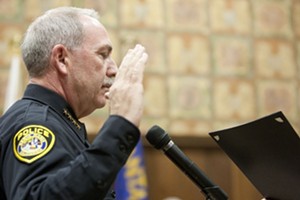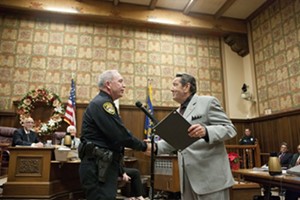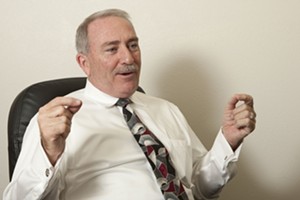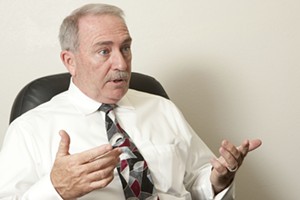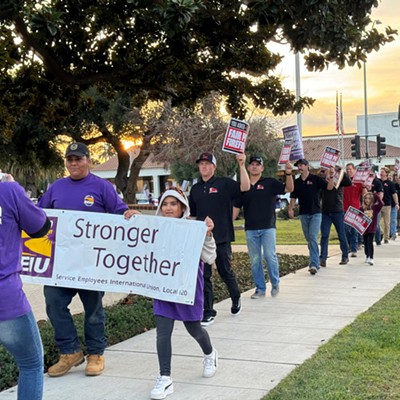Dec. 18 was an emotional evening in Santa Maria, at least for the 100-plus people crammed into City Council chambers on South McClelland Street. After a turbulent year that included eight officer-involved shootings, law suits, and the retirement of longtime Police Chief Dan Macagni, the city finally got a new leader in retired Los Angeles Sheriff’s Department Commander Ralph Martin.
Martin, who’s served as interim chief since August, has an extensive background in gang-related and community-based policing, as well as internal affairs.
At the City Council meeting, Santa Maria City Manager Rick Haydon said he believes Martin will be able to build bridges in our community.
“I think that’s something we’re looking for right now in Santa Maria,” Haydon said.
Two days after the swearing in, the Sun sat down with Martin to ask him about his plans for the Santa Maria Police Department.
In his own words
Sun: What made you decided to apply for the full-time position of police chief?
Martin: Well, I alluded to it a little bit at the City Council meeting [on Dec. 18]. ... I just felt, after talking to the City Manager [Rick Haydon] for a period of time, that the processes that I have put into place I wanted to see continue. And that’s not to say that another person couldn’t come in and do a great job; I know they could. But I think just another transition after six months would really put the department in another change mode, and I think that’s the last thing, given the past year, that the department needs to go through.
Sun: So is your family coming up from Orange County?
Martin: Yeah, but just to let you know, I don’t want to talk about family. ... We’ve got issues with gang members doing things in the city with our officers and other things, so I want to stay away from that.
Sun: OK.
Martin: My family will come up, but my kids are all grown.
Sun: No problem. Whatever makes you feel safe.
Martin: A lot of people always say, ‘Well, where are you living?’ And I’m like, ‘Umm, you know ... .”
Sun: [Laughs] I don’t need to know that.
Martin: [Laughs] Nobody really does because we do have some issues right now.
Sun: Can you elaborate on that a little bit?
Martin: No, I can’t.
Sun: OK. ... What was your first impression of the police department when you got here [in August]?
Martin: Well, my first impression was that, ‘Gosh, you’re in a really old building.’ [Laughs] Then I realized it was built in 1953 or so—and you have such a big, burgeoning population—and there’s not enough room in this building for 160 people. Now, granted, not all 160 work at the same time, but still there are an awful lot of things that are going on. So square-footage-wise and what we need with contemporary equipment and other things, we’re simply outdated by 30 to 40 years. So I was really heartened to know that they have a new building for us and we’re going to be moving in in about a year or so. It’s fabulous. I’ve been in there a couple times now.
Sun: Where is that again?
Martin: It’s at 1111 Betteravia Road, right on the corner of Skyway and Betteravia—where Lockheed Martin used to be. And we’re going from 22,000 square feet here to 72,000 square feet.
Sun: That’s great. I remember when they announced that.
Martin: Right. The city purchased the property several years ago with the idea that we would move in. The building is 30 years old, but it’s very nice; it’s very well built because it was designed for high electronics for Lockheed Martin. ... November of 2013 is when we’re ready to go.
Sun [photographer Steve Miller]: So is there going to be a jail facility in there also?
Martin: No. The county is building the new jail on the west side of town. ... It will probably be ready in about four or five years. We’re still going to have to book at Orcutt down there in the Sheriff’s Department facility, which is really a poor process for us right now because I have to take several officers every day and transport down to Santa Barbara. It’s very time consuming. It takes resources out of the city, but the Sheriff’s Department is also short-handed.
Sun: Every day? Wow.
Martin: Almost every day. Now, they do open the jail for us over in Orcutt from about 7 at night to 4 in the morning. So that helps us, but unfortunately when we detain someone in the morning hours up until noon, we only want to keep people there for five or six hours at a time, so we have to transport them.
Sun: When you came in as interim police chief in August, I’m sure you were aware of the problems the city was having—
Martin: You know, I really wasn’t. I knew of the Covarrubias shooting. I was aware of it when I was down in L.A., but I really didn’t know any circumstances about it. If you would have asked me which city it was in, I probably couldn’t tell you. I just knew it was a Central Coast city.
Sun: So they didn’t mention that [in the hiring process]?
Martin: No, what happened was the city manager was looking for someone to serve as interim, and my name had come up from several people down in L.A. Mr. Haydon contacted me and we talked for a while. I eventually told him I would come up for the interim job.
Sun: Yes, you said you would stay for only five or six months.
Martin: Right, but it’s difficult to be interim for five or six months when you’re in an environment where you’ve got a lot of issues happening. Once you get entrenched in it, it’s really difficult to hand it off to someone else—the learning curve would be so high—I mean, I’ve been doing this for almost five months now. And, quite honestly, most of the investigations are coming to fruition right now.
Sun: We at the Sun have reported on the police department extensively. So from your perspective, coming in as an objective party, can you tell me more about some of the department’s issues?
Martin: First, just to let you know, I have extensive background in officer-involved shootings. [While working for the Los Angeles County Sheriff’s Department] either my partner or I, in a five-year period, responded to 118 of them. That’s one officer-involved shooting every two weeks for five years. Either my partner or I was the senior person on the scene. So I have been to an awful lot of scenes. So, given that, I think Mr. Haydon probably realized I was someone who could look [at the shootings] objectively. It started in December of 2011 with the Agnes [Street] shooting where Sammy Ceballos was killed. He was an armed suspect. Unfortunately, two of our officers were also hit. The District Attorney has looked at these cases and deemed them to be justifiable in a criminal sense, but I’m looking at them in a tactical and administrative policy sense. They’re two completely separate things.
Sun: Is what happened with Samyr typical?
Martin: We’ve had officers get shot and killed in scenes like that, and we’ve had friendly fire and things like that. In this one, I’m going to look at the tactical [operations] and how we put ourselves in a position [that allowed] something like that to happen. Sometimes the suspect’s motions—when they come into the middle—cause a crossfire; that we understand. But sometimes you have to ask yourself, “How were you in the position to cause the crossfire to begin with?” These things are very fluid and they happen in less than five seconds. So I’m not looking at it in terms of discipline; I’m looking for future tactical operations to prevent these types of things.
Sun [Steve Miller]: Does it affect officers’ morale because they get embarrassed when things like that happen?
Martin: It can, but you know, you have to look at it. It’s not any different than any other major thing that happens. ... We have to learn from these things. That’s why we have so many videos that we can look at. We’re putting a library together of things that have happened in the last 20 to 25 years across the country—something we don’t have here. The incidents—I’m not startled by the numbers, if that’s what you mean. We’ve had four officer-involved shootings and the Albert Covarrubias shooting makes it five. We had another that involved the Sheriff and us and the highway patrol ... and another behind the 7-Eleven. All of the suspects in these cases—every one of them—have been armed. All of them had functional weapons with rounds in the chamber. Whether they’re the suicide-by-cop type of thing or parolees trying to escape, the reaction time for these kinds of things is milliseconds.
Sun: When I interviewed Police Chief Larry Ralston over in Lompoc he said more people are carrying and pulling guns on police officers.
Martin: Yeah. What we’re seeing is there’s a reduction of crime nationally in certain violent behaviors, but in the individual cases the suspects are more desperate ... more violent.
Sun: Why do you think that is?
Martin: I don’t want to allude to AB 109 [legislation that will transfer tens of thousands of lower-level state inmates to county jails over the next few years] yet because we did have a murder victim who was released from prison—he was involved in a shooting last year; he was wounded, there was a gang shooting and he had been shot. ... He was released and he became a victim out on the street. We’re not sure if it’s retaliation yet or not.
Sun [Steve Miller]: Do you think the rise in crime has anything to do with—or there’s any correlation to—the economy going downhill?
Martin: No, there’s actually not. It’s interesting; you would think the economy is down so crime would exponentially go up, but it doesn’t. We’re not quite sure why. ... A lot of it has to do with the median age of males between the ages of 13 and 21. You’ll see different time periods where ... there happened to be a lower percentage of males between the ages of 13, 14 and, say, 21, 22, and the crime rates dropped because [that group was] committing 75 to 80 percent of the crimes.
Sun [Steve Miller]: Yeah, the guys who wrote the book Freakonomics actually talked about that.
Martin: Yeah, they talked about it. They allude to a lot of different things in that book, even abortion rates. There are a number of things that cause crime rates to drop when the male population in the median age range of 13 and 21 decreases.
Sun: One thing I’ve found interesting—and I’m not sure if it’s a coincidence or if it’s been impacted by your coming here and Chief Dan Macagni leaving—but it seems like the officer-involved shootings stopped once you took over the reigns of the Santa Maria Police Department
Martin: I don’t know if there’s any direct correlation to that. I don’t think there is. We just saw last Friday [Dec. 14] a suspect who ran from us. We engaged in a pursuit. He threw a gun out of the window of the vehicle ... and he subsequently surrendered. We don’t know what we would have prevented in that. Could that have been an officer-involved shooting? It certainly could have. We don’t know what he was en route to do. We do know that we prevent crime, but there’s no real way of capturing data. It’s like proving a negative. We know by our presence that people will not commit a crime while we’re there.
Sun: There are still quite a few people in this town who do not trust the police and who don’t feel safe. As police chief, what would you like them to know?
Martin: ... There are two areas that police are usually gauged by: How well they handle crime and public trust. Public trust can be gauged and evaluated through the process of sending out several hundred questionnaires. That’s something I plan on doing next year. ... We’re going to spread these questionnaires around a number of areas. We’re going to give them to teachers, deputy public defenders, the DA’s office, businesspeople, students, and we’re also going to give them to people we’ve arrested. Now that’s kind of an eyebrow raiser in some ways, but we don’t know how effective we are ... unless we get people to respond to these questions. We did this many years ago down in L.A. and we came to understand that there were several areas in which we were deficient. That’s why we started town hall meetings and more community-based policing.
Sun: You’ve mentioned in the past that community-based policing is one of your main focuses.
Martin: That’s one of the first things I did when I got here; within a month or two, I re-established community-based policing. ... I didn’t have the resources to do it, but it’s so important to do that I carved it out of patrol. I took three officers out of patrol, put them back in the community, and put a sergeant in charge of them. ... Their first priority is to handle all of those quality-of-life issues. I gave them cell phones from the city; people can call them direct while they’re in their patrol cars and they can come right over. These are issues that normally people wouldn’t call us about; they’re not going to call 911 because it’s not an emergency, they’re not going to call us because they know we handle a huge volume of calls and we’re very busy. ... But if you can call a patrol officer on his cell phone in his car and he can get right over there, he can handle all of those quality-of-life issues like abandoned cars, vandalism, and yard sales. ... It’s the “Broken Windows” theory that we’ve talked about since New York and L.A. implemented [programs]: Fix the small things, and the bigger things start to go away.
Sun: One of the bigger things you mentioned the last time we spoke was prostitution. The city had some trouble with prostitution about 10 years ago, but a lot of people thought it was eradicated.
Martin: No. We have a huge problem with prostitution in this city. Most of the working ladies are coming down from Oakland, they’re coming in from Bakersfield and Fresno ... and working the motels … and out of cars.
Sun: How do you plan to address that?
Martin: We’ve got some plans in place to impact it. ... It’s difficult to go after them when they’re from out of town because you’d like to go after the pimps, but they’re not here. They’re sending girls into Santa Maria who have to work and bring back a certain amount of money.
Sun: Why are they sending them to Santa Maria?
Martin: Because it’s a soft target.
Sun: How so?
Martin: We haven’t enforced the vice laws here.
Sun: Do you know why that is?
Martin: Because we were too short [on staff]. There are three areas that we normally cut back on when we’re very short on personnel and we don’t have the money: We quit hiring, we cut back our training, and we cut back on what sometimes is referred to as “victimless crimes,” but they’re not really victimless crimes. The vice crimes are one of the areas we have to cut back on because answering 911 calls is more important than going after a prostitute. We have to triage in our tough times.
Sun: How do you plan to address the city’s financial problems while still offering quality police services?
Martin: Well, the city’s in fairly good shape. Then the residents, when they passed Measure U, I think they sent a loud message. Measure U is a one fourth of one penny increase in the sales tax that specifically goes to public safety. Now, it might not seem like a lot, but hopefully at the end of the fiscal year it will net somewhere in the area of $3 million. That’s a substantial amount of money. We can certainly hire a lot of police officers and have a greater impact. The city has allowed me to fill the eight or 10 vacancies that we currently have, and add five more sergeants that we didn’t have before. … So we go from 10 openings to 15 after the promotions.
Sun: I imagine that’s helped improve morale.
Martin: It’s a huge morale boost; the department hasn’t had an increase in salary in many, many years. We’re the second lowest-paid department in the county. But the officers are mature enough to understand that the city has to be fiscally sound before we can do anything else. We have a very sharp city manager who knows what to do and who is meeting with the unions, letting them know that there’s light at the end of the tunnel, but that we need to be fiscally sound.
Sun [Steve Miller]: Is there a preference to hiring officers who speak Spanish?
Martin: Sure. Yeah, I’m looking for minorities and females, specifically. Our most recent hire is a female officer who is from India. … She’s out on patrol right now.
Sun: Are there any new programs that you’re excited about?
Martin: The most significant one is that we’re going to increase the number of school resource officers from two back up to four or five.
Sun: Does that have anything to do with the shootings at Sandy Hook Elementary School?
Martin: It has a great deal to do with that because when you put an officer on the campus you have a better relationship with people and they’re more willing to talk, they’re more willing to share things. We’ve seen that school issues decrease when people talk to the officers on campus. … We prevent fights, and we prevent thefts.
Sun: All campuses?
Martin: High schools initially and then we’ll lower it down to the junior highs, and we’ll eventually restore the DARE officer.
Sun: Gang recruitment out of the high schools is an issue. How do your officers plan to address that?
Martin: We have to go to the lower levels; by the time they’re in high school it’s too late. So we have to impact them at the elementary school level because that’s actually when they’re getting [targeted]. The program is all-inclusive. We just graduated about 500 kids from the DARE program. It was held at the [Santa Maria] Elk’s Lodge. ... It was just fabulous.
Sun: Are there any other programs you’re championing?
Martin: Internally there’s COMSTAT … the computer statistic-driven data that forces the officers to be more in tune specifically with all of the things that are happening within their beat area. Then they have to take responsibility for, and ownership of, those crimes—I ask them what they’re going to do specifically to reduce those crimes, and they have to stand and deliver. ... In other words, rather than just being reactionary, I want them to get out there and be proactive and be preventative. ... Usually you get so busy, you just end up answering call after call and chasing the radio. Well, those days in Santa Maria are over. We’re going to get out in front of it and try to prevent crimes before they happen.
Sun: What are some preventative measures you’re looking at for specific crimes?
Martin: Rather than just going to a briefing and saying, “What happened yesterday or the day before?” and, “Be on the lookout for this car or that car,” we can [use COMSTAT] to generate what we think are future trends and go out and stop the crimes from happening.
Sun: What is your stance on transparency in policing? That became an issue under Chief Macagni. As a member of the media, I found him very difficult to get a hold of. I was surprised that you answered your phone on the second ring the other day.
Martin: Well, that’s part of it—I answer my own [office] phone, and I answer my own cell phone. ... I went to the town hall meeting on Oct. 11 and I got up and went into great detail—without naming names—about all of the 10 or 12 major crimes that have occurred in the last 12 months, including the Covarrubias shooting and the other officer-involved shootings. That was videotaped. ... That should have been an indication that I’m pretty transparent and I’m going to be upfront. ... Everyone in the department who’s at the scene is encouraged to speak to the press. In other words, we’re not just going to wait for the [Public Information Officer] to show up. I’m encouraging everyone to be open. And, quite honestly, they make better spokespersons anyway because they’re the ones handling the scene. … I was a PIO in Los Angeles for three years.
Sun: You’ve done a lot of things in your career. What are some other key experiences?
Martin: I worked closely with the FBI and I went to Central America. I spent time in El Salvador, so I’m pretty up to speed on the MS 13 gang and 18th Street gang. My specialty when I worked as a gang investigator was Bloods and Cripps down in south Los Angeles.
Sun: You mentioned in a past interview that MS 13 didn’t actually start in El Salvador.
Martin: It didn’t start in El Salvador. … After the revolution in ’85 in El Salvador, about 100,000 to 200,000 people immigrated to the United States and they all ended up in the Pico Union area in Los Angeles. … They all came as young kids and they were surrounded by 18th Street [gang members]. They realized quickly after a couple years that if they didn’t defend themselves, they would all be victims forever. So they formed Mara Salvatrucha, which is MS 13. Thirteen is just indicative of the letter “m” and marijuana. They became very strong and they were very ruthless because having come out of the revolution that was down there, they saw a lot of violence—on the streets, in front of their houses. Life was very cheap in El Salvador. … As a result of that, the LAPD and the Los Angeles Sheriff’s Department ended up arresting a lot of MS 13 members. We deported about six or seven thousand of them. They are now the main problem down in El Salvador and that’s why we went back down there to help them set up a fingerprint system and gang investigation system. We brought their officers up here to L.A. and trained them in how to interview and organize and put these investigations together. … So [MS 13] was created here in the United States and exported back to El Salvador.
Sun: Why do you think gangs are attracted to Santa Maria?
Martin: Well, the gang members we have here—we’ve got about 1,200 gang members—are just generational. I think a lot of them are second and third generation. … It’s interesting here because you can have different gangs living on the same street. That doesn’t happen in L.A. I could draw lines on a street map through Compton and tell you which gangs are where. It’s different here.
Sun: I wonder why that is?
Martin: I don’t think there’s the same level of violence here. There’s not as great of a territorial mandate as down in L.A. … They’re criminals and they’re violent, but not as violent as in other areas. I mean, let’s face it, we’ve had two homicides this year [in Santa Maria]. Both of them were domestic.
Sun: Domestic violence?
Martin: Yeah, boyfriend on girlfriend and husband on wife. Those are the only two homicides that we’ve had this year.
Sun: Besides the officer-involved shootings.
Martin: Yes, but they don’t classify those as murders. They’re justified homicide.
Sun: There seems to be a lot of tension between the older-generation Santa Marians, many who are white and whose families have been here for a long time, and immigrants—
Martin: You know, I’m not really aware of that. Politically there could be—most older people tend to vote, I don’t care if they’re Hispanic or white. I don’t get any indication that there’s [racial tension]. I look at the City Council and there’s a mixed City Council, there are people in city government. The police force is a prime example; I’ve got a significant number of Hispanic officers and I’m always looking for more. I don’t see that as a problem in Santa Maria.
Sun: To put it bluntly, what about the idea of blaming Mexicans for all of the gang violence?
Martin: That harkens back to the Oct. 11 town hall meeting when I was asked, “Why do you continually arrest so many Hispanic gang members?” and I said, “Well, because I don’t have any Asian gang members here that I’m aware of.” If you are 70 percent of the population, it would stand to reason that you commit 70 percent of the crime. … I was working in an all African American area when I was a gang investigator, and I could have been accused of just arresting blacks. It’s kind of a silly question when you think about it. It just doesn’t make sense. When you look at the reality of it, Hispanic gang members who happen to be 70 percent of the population are committing 70 percent of the crime.
Sun: What about internally in the police department? There were some questions raised by members of the police officers’ association about racism and cronyism within the department. Have you had to deal with any fallout from that?
Martin: I think every organization has nepotism to a degree. What I’ve done is open up the promotional process to all members and to all outside agencies [across the state of California]. So if somebody wants to be a lieutenant in the Santa Maria Police Department and they currently work in Santa Barbara, they can apply here.
Sun: What made you decide to do that?
Martin: Because I think by opening it up you get a better pool of qualified people. … We have a lot of great people here, but why not spread it even wider and maybe get that great diamond out there?
Sun: What was the department’s reaction to that?
Martin: They’re fine with it. … We have a very young department here so it’s important to have mature leadership, people to come in and mentor. I’m a big believer in mentoring. I want to leave the department in better hands than I found it.
Sun: How did you find the department?
Martin: There’s a lot of self-analysis going on, doubts. There’s a significant amount of questioning and introspection that’s going on. Given what they’ve gone through, I can understand that. I mean, it’s a difficult job. We run 24/7, we don’t take a break. You might be able to shut your studio down or shut your offices down, but we don’t do that. … It takes five people to fill one spot. … I need five officers to fill one car. There are 21 shifts in a week. It takes four officers plus a fifth of one to fill 21 shifts. The four fifths of the officer fills in for all of [the other officers’] vacation time and training time for the rest of the year. I need five dispatchers to fill one chair.
Sun: So the window up front is closed right now because of budget reasons?
Martin: Yeah, that’s exactly right. … When you’re at your house and you need to call a police officer at 2 o’clock in the morning, we can’t say, “I’m sorry, I’m only an eight-hour shift.” You want somebody there.
Sun: That’s crazy
Martin: It is crazy, and that’s why it’s so darn expensive.
Contact Managing Editor Amy Asman at [email protected].


